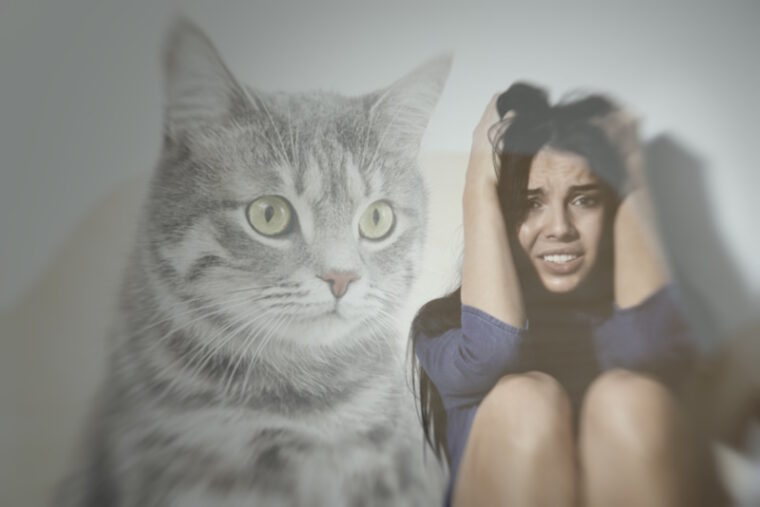
Click to Skip Ahead
Have you ever found yourself frozen in fear at the sight of a cat? If so, you’re not alone! What you’re experiencing is known as ailurophobia. While it might sound like a word from a spelling bee competition, it’s actually a term that describes an intense and irrational fear of cats. It’s important to understand that this isn’t just about disliking cats or being mildly uncomfortable around them. It’s a fear so powerful that it can feel like your life has been turned upside down.
The world is filled with cat lovers who find peace and joy in their feline friends. But for those grappling with ailurophobia, even a picture of a cat can set their heart racing. The mere thought of encountering a cat can fill their day with dread and anxiety, making simple daily tasks seem like insurmountable challenges. Let’s learn more about ailurophobia in this article.
What’s Up With Ailurophobia?
Ailurophobia is derived from the Greek words “Ailuros,” meaning cat, and “phobos,” meaning fear. So, it’s essentially a medical term for the fear of cats. For someone with this phobia, the mere thought of a cat can cause distress and anxiety that’s way out of proportion to any actual threat a cat might pose. It’s like having a horror movie playing on repeat in their minds, where the villain is a harmless house cat.
While most people might find cats adorable and comforting, individuals with ailurophobia perceive them as terrifying creatures. Their fear is all-consuming and irrational, and it can be hard for them to understand why others don’t see cats the same way.
Prevalence
Although we don’t have exact numbers on how many people are living with ailurophobia (let’s face it, it’s not easy admitting to being scared of fluffy little munchkins), it’s definitely not a rare condition. People of all ages, backgrounds, and cultures can experience it. It’s a universal fear, showing that phobias don’t discriminate – they can affect anyone, anywhere.
In fact, you might know someone with ailurophobia and not even realize it. They might avoid visiting homes with cats, skip events where cats might be present, or even cross the street to avoid a stray cat. These are all signs that someone might be dealing with this intense fear.

Why Are Some People Scared of Cats?
Traumatic Experiences
One of the most common causes of ailurophobia is past traumatic experiences involving cats. This could range from being attacked or bitten by a cat during childhood, witnessing aggressive cat behavior, or even just getting a fright from a cat jumping out unexpectedly. These incidents can leave a deep imprint on a person’s mind, leading to a lifelong fear of cats.
These traumatic experiences create a strong association between the fear and the memory of cats. So, when individuals with ailurophobia encounter a similar situation later in life, their brain triggers a panic or anxiety response. It’s as if their brain is trying to protect them from a perceived danger, even though the threat isn’t real.
Learned Fear
Ailurophobia can also develop through observational learning, or as we like to call it, the ‘monkey see, monkey do’ kind of fear. If a person sees others, especially influential figures like parents, reacting fearfully to cats, they may adopt the same fear. It’s like the fear is contagious, passing from one person to another through observation and imitation.
Children, in particular, are very impressionable. They look up to adults for cues on how to behave and respond to different situations. So, if a child sees a parent or caregiver reacting with fear every time a cat is nearby, they may learn to associate cats with fear and danger, eventually leading to ailurophobia.
Genetic and Environmental Factors
Our genes and environment can also contribute to the development of this phobia. Some people might be genetically more prone to anxiety disorders, including specific phobias like ailurophobia. This means that if you have a close family member with an anxiety disorder or specific phobia, you might be at a higher risk of developing one too.
Environmental factors play a significant role as well. Cultural beliefs, societal attitudes towards cats, and superstitions can all stir up fear in individuals. For instance, in some cultures, cats are considered bad luck. Such beliefs can instigate fear and contribute to the onset of ailurophobia. Similarly, if cats are often portrayed negatively in media and literature, this can foster fear and misunderstanding about these animals.

How Does Ailurophobia Present?
Physical Symptoms
When someone with ailurophobia encounters a cat or even thinks about one, their body might go into fight-or-flight mode. This is the body’s natural response to perceived threats, preparing the person to either confront the threat (‘fight’) or escape from it (‘flight’). During this response, the person might experience physical symptoms like a rapid heartbeat, sweating, trembling, difficulty breathing, and nausea.
Each of these symptoms is the body’s way of gearing up to deal with the perceived threat. The rapid heartbeat ensures that blood is pumped quickly to the muscles in preparation for action. Sweating helps cool down the body, while trembling occurs as the muscles tense up in anticipation. Difficulty breathing happens as the body tries to take in more oxygen, and nausea is a result of the digestive system slowing down so that more energy can be directed towards dealing with the threat.
Behavioral Symptoms
Behaviorally, ailurophobia manifests as avoidance behavior. Individuals with this phobia will often go to great lengths to avoid anything to do with cats. They might decline invitations to visit friends who own cats, avoid areas known for stray cats, or even change their usual route just to avoid passing by a house where a cat lives.
This avoidance can significantly limit their activities and lifestyle, making them miss out on a lot of fun experiences. In severe cases, their fear might even make them become reclusive, preferring to stay within their safe space where they can control their environment and ensure there are no cats around.
Psychological Symptoms
Psychologically, individuals with ailurophobia may experience intense fear or anxiety when thinking about cats. Their dreams might be invaded by cats, and they may constantly feel the need to check their surroundings for the presence of cats. This constant state of anxiety can lead to mental exhaustion and affect their overall well-being.
Living in a state of constant fear can be emotionally draining. It’s like being in a horror movie that never ends, where every shadow could be a cat lurking in the corner. Over time, this can take a toll on their mental health, leading to further issues like depression or other anxiety disorders.
How Can Ailurophobia Be Treated?

Cognitive-Behavioral Therapy (CBT)
If you’re struggling with ailurophobia, don’t lose hope. There are several effective treatments available, and cognitive-behavioral therapy (CBT) is one of them. CBT is all about flipping the script in your mind, changing the negative thoughts that cause fear, and learning ways to manage anxiety.
During CBT, a therapist will help you identify the harmful thoughts that trigger your fear of cats. Together, you’ll work on replacing these fear-inducing thoughts with more positive, realistic ones. For example, instead of thinking “All cats are dangerous,” you might start thinking, “Most cats are harmless, and I can handle being around them.”
Exposure Therapy
Another effective treatment option is exposure therapy. Think of it as gradual immersion into your fear until you start feeling less afraid. It’s like learning to swim by first getting used to the water before diving into the deep end.
Exposure therapy starts with minimal contact with the feared object, which in this case is cats. Initially, you might just look at pictures of cats or talk about them. As you become comfortable, the therapy progresses to more direct encounters, such as being in the same room as a cat. Eventually, the goal is to get you to a point where you can touch or even hold a cat without fear.
Medication
In severe cases, medication can be prescribed to help manage the symptoms of anxiety and panic associated with ailurophobia. Remember, though, that medication should always be taken under the guidance of a healthcare professional and usually in combination with other treatments like therapy.
Medications like anti-anxiety drugs or certain types of antidepressants can help manage the physical symptoms of anxiety and panic. But it’s important to remember that medication doesn’t cure phobias – it just helps you manage the symptoms. Therefore, it’s usually used as part of a comprehensive treatment plan that includes psychotherapy.
Conclusion
While ailurophobia might not be a topic that comes up at dinner parties, it is a real condition that affects many people. By understanding what it is, why it happens, and how it affects people, we can better support those dealing with it. So, if you or someone you know has ailurophobia, remember – it’s okay to seek help and take steps towards overcoming your fear. After all, every cat deserves a chance to show its lovable side!
Featured Image Credit: New Africa, Shutterstock







